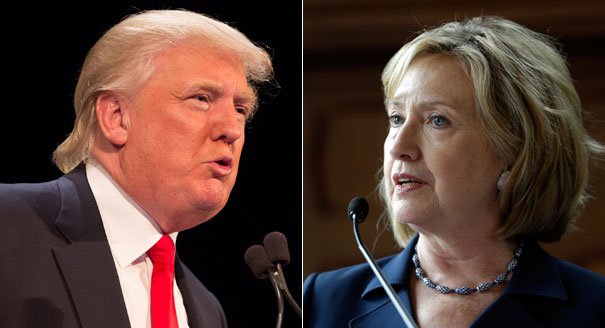
Hillary Clinton and Donald Trump are in a near tie in Rasmussen Reports’ latest weekly White House Watch.
The national telephone and online survey of Likely U.S. Voters finds Clinton with 40% support to Trump’s 39%. Fourteen percent (14%) like some other candidate, while seven percent (7%) are undecided. (To see survey question wording, click here.)
Last week in the debut White House Watch survey, Trump held a 42% to 37% lead, but hypothetical matchups between the two likely major party presidential candidates have been close since Rasmussen Reports first began them last October.
Neither candidate is showing any significant gain in support and appears to have yet dented the unfavorable perceptions that many voters have of them.
Clinton earns 77% of the Democratic vote, while 72% of Republicans favor Trump. Each candidate draws 12% support from voters in the opposing party. Among voters not affiliated with either major party, Trump leads 34% to 30%, but 37% prefer someone else or are undecided.
Rasmussen Reports will update the Clinton-Trump White House Watch matchup numbers every Thursday morning from now until Election Day in November.
(Want a free daily e-mail update? If it’s in the news, it’s in our polls). Rasmussen Reports updates are also available on Twitter or Facebook.
The survey of 1,000 Likely Voters was conducted on May 23-24, 2016 by Rasmussen Reports. The margin of sampling error is +/- 3 percentage points with a 95% level of confidence. Field work for all Rasmussen Reports surveys is conducted by Pulse Opinion Research, LLC. See methodology.
Vermont Senator Bernie Sanders polls better against Trump than Clinton does but is not expected to stop her in the race for the Democratic presidential nomination.
Clinton posts a 16-point advantage among women, but Trump leads by 12 points among men. While much has been written and said about Trump’s gender gap with women, it appears Clinton has a similar problem with men.
Those under 40 have been a key element of the Democratic base vote in recent elections, but these voters are closely divided given a hypothetical Clinton-Trump contest.
Clinton continues to benefit from overwhelming support among blacks. Trump leads among whites but trails among other minority voters.
The U.S. economy historically has had an average growth rate of 3.3% but has fallen short of that number in every year of Barack Obama’s presidency. Still, his fellow Democrats give the president positive marks for his economic performance and think Clinton would do more of the same. Trump is expected to make the economy better by all voters – except Democrats.
These findings are in line with surveys Rasmussen Reports has done on other issues, including national security, diplomacy, illegal immigration and the selection of the next justice to the U.S. Supreme Court. Republicans firmly believe Trump will do better, and unaffiliated voters tend to agree. Democrats feel strongly that Trump will do worse and don’t expect any major changes if Clinton is the next president.
Voters think the media is even more prejudiced now against Trump in favor of Clinton.



Expositores: Oscar Vidarte (PUCP) Fernando González Vigil (Universidad del Pacífico) Inscripciones aquí. Leer más
Una retrospectiva para entender los próximos cuatro años. Leer más
En la conferencia se hará una presentación de los temas más relevantes del proceso de negociación se llevó a cabo desde el 2012, así como del acuerdo de paz firmado entre el Gobierno colombiano y la guerrilla de las FARC a finales del 2016. Se analizarán los desafíos y las... Leer más
El Observatorio de las Relaciones Peruano-Norteamericanas (ORPN) de la Universidad del Pacífico es un programa encargado de analizar y difundir información relevante sobre la situación política, económica y social de Estados Unidos y analizar, desde una perspectiva multidisciplinaria, su efecto en las relaciones bilaterales con el Perú.
© 2025 Universidad del Pacífico - Departamento Académico de Humanidades. Todos los derechos reservados.

